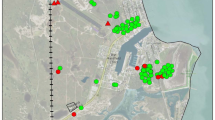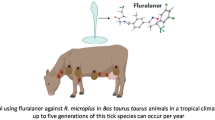Abstract
Deer self-treatment devices (‘4-posters’) were evaluated for their efficacy in reducing populations of blacklegged ticks, Ixodes scapularis, and lone star ticks, Amblyomma americanum. At each of three locations in Maryland, 25 ‘4-posters’ were operated in study areas of approximately 5.18 km2. Populations of host-seeking ticks were monitored by flagging of treated areas and similar untreated control areas without ‘4-posters.’ From 1998 to 2002 the percent mortalities achieved were 69, 75.8 and 80 at the three study sites infested with I. scapularis nymphs, and 99.5 and 95.3 for A. americanum nymphs at the two sites where this species occurred.
Similar content being viewed by others
References
Bloemer, S.R., Zimmerman, R.H. and Fairbanks, K. 1988. Abundance, attachment sites, and density estimators of lone star ticks (Acari: Ixodidae) infesting white-tailed deer. J. Med. Entomol. 25: 295-300.
Carroll, J.F. 2003. Survival of larvae and nymphs of Ixodes scapularis Say (Acari: Ixodidae) in four habitats in Maryland. P. Entomol. Soc. Wash. 105: 120-126.
Carroll, J.F. and Kramer, M. Winter activity of Ixodes scapularis (Acari: Ixodidae) and the operation of deer-targeted tick control devices in Maryland. J. Med. Entomol (in press).
Clark, D.D. 1995. Lower temperature limits for activity of several ixodid ticks (Acari: Ixodidae): effects of body size and temperature change. J. Med. Entomol. 32: 449-452.
Duffy, D.C. and Campbell, S.R. 1994. Ambient air temperature as a predictor of activity of adult Ixodes scapularis (Acari: Ixodidae). J. Med. Entomol. 31: 178-180.
Duncan, I.M. and Monks, N. 1992. Tick control on eland (Taurotragus oryx) and buffalo (Syncerus caffer) with flumethrin 1% pour-on through a Duncan applicator. J. S. Afr. Vet. Assoc. 63: 7-10.
Fish, D. and Dowler, R. 1989. Host associations of ticks (Acari: Ixodidae) parasitizing medium sized mammals in a Lyme disease endemic area of southern New York. J. Med. Entomol. 26: 200-209.
Henderson, C.F. and Tilton, E.W. 1955. Tests with acaricides against the white flour mite. J. Econ. Entomol. 48: 157-161.
Jones, C.J. and Kitron, U.D. 2000. Populations of Ixodes scapularis (Acari: Ixodidae) are modulated by drought at a Lyme disease focus in Illinois. J. Med. Entomol. 37: 408-415.
Liegner, K.B. 1991. Acaricide dispenser. US Patent # 5,050, 539 dated 24 September 1991.
Marchinton, R.L. and Hirth, D.H. 1984. Behavior. In: White-tailed Deer: Ecology and Management, L.K. Haile (ed.), pp. 129-168. Stackpole Books, Harrisburg, PA.
Pound, J.M., Miller, J.A., George, J.E. and LeMeilleur, C.A. 2000a. The '4-poster' passive topical treatment device to apply acaricide for controlling ticks (Acari: Ixodidae) feeding on white-tailed deer. J. Med. Entomol. 37: 588-594.
Pound, J.M., Miller, J.A. and George, J.E. 2000b. Efficacy of amitraz applied to white-tailed deer by the '4-poster' topical treatment device in controlling free-living lone star ticks (Acari: Ixodidae). J. Med. Entomol. 37: 878-884.
Schmidtmann, E.T., Carroll, J.F. and Watson, D.W. 1998. Attachment-site patterns of blacklegged ticks (Acari: Ixodidae) on white-tailed deer and horses. J. Med. Entomol. 35: 59-63.
Sonenshine, D.E., Allen, S.A., Norval, R.A.I. and Burridge, M.J. 1996. A self-medicating applicator for control of ticks on deer. Med. Vet. Entomol. 10: 149-154.
Watson, T.G. and Anderson, R.C. 1976. Ixodes scapularis Say on white-tailed deer (Odocoileus virginianus) from Long Point, Ontario. J. Wildlife Dis. 12: 66-71.
Wilson, M.L., Adler, G.H. and Spielman, A. 1985. Correlation between abundance of deer and that of the deer tick, Ixodes dammini (Acari: Ixodidae). Ann. Entomol. Soc. Am. 78: 172-176.
Wilson, M.L., Telford III, S.R., Piesman, J. and Spielman, A. 1988. Reduced abundance of Ixodes dammini (Acari: Ixodidae) following elimination of deer. J. Med. Entomol. 25: 224-228.
Author information
Authors and Affiliations
Rights and permissions
About this article
Cite this article
Carroll, J.F., Allen, P.C., Hill, D.E. et al. Control of Ixodes scapularis and Amblyomma americanum Through use of the ‘4-poster’ Treatment Device on Deer in Maryland. Exp Appl Acarol 28, 289–296 (2002). https://doi.org/10.1023/A:1025383408163
Issue Date:
DOI: https://doi.org/10.1023/A:1025383408163




